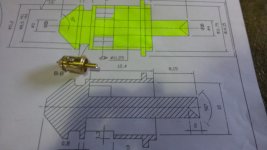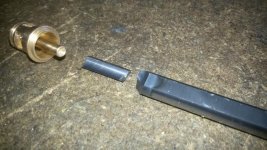ricardo_gt
Aluminum
- Joined
- Aug 5, 2012
- Location
- Portugal
Hi people!
Long time i did not had such a part i could not machine on a easy way... I need to machine 10000parts, brass material.
So, i have this part, look inside it... first i tougth it would be easy and i made a carbide custom tool... 1500 rpm, F0.04mm/rot, it made 1038 parts, exactly. Then i taugth, maybe, hss custom tool could do it better on brass...no, not a single part,it destroyd it at first part. Then, i used a 2 flute carbide 4mm diameter long mill: 47 parts and very very slowly. I used a 2nd one with double feed, 500m/min, only 7 parts...so, i changed again to the custom tool, coated carbide this time... as you can see on the photo, did not last long, using 1000rpm and feed 0.04 mm/rot,
83parts...now i am tinking about using a 10mm mill,pasma cuted at center,
4mm diameter and try again...problem is i have to send the mill out to another shop,
pay for it and have no idea if it will work or not. Can you give some advice? Thank you! Best regards!
T

Long time i did not had such a part i could not machine on a easy way... I need to machine 10000parts, brass material.
So, i have this part, look inside it... first i tougth it would be easy and i made a carbide custom tool... 1500 rpm, F0.04mm/rot, it made 1038 parts, exactly. Then i taugth, maybe, hss custom tool could do it better on brass...no, not a single part,it destroyd it at first part. Then, i used a 2 flute carbide 4mm diameter long mill: 47 parts and very very slowly. I used a 2nd one with double feed, 500m/min, only 7 parts...so, i changed again to the custom tool, coated carbide this time... as you can see on the photo, did not last long, using 1000rpm and feed 0.04 mm/rot,
83parts...now i am tinking about using a 10mm mill,pasma cuted at center,
4mm diameter and try again...problem is i have to send the mill out to another shop,
pay for it and have no idea if it will work or not. Can you give some advice? Thank you! Best regards!
T






